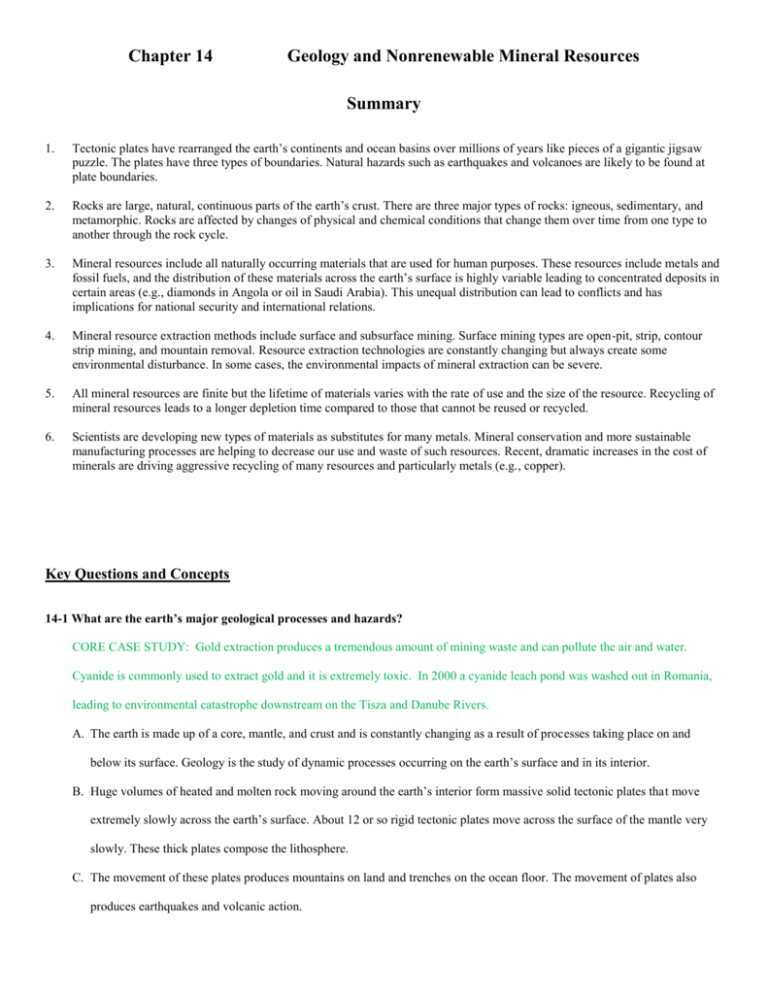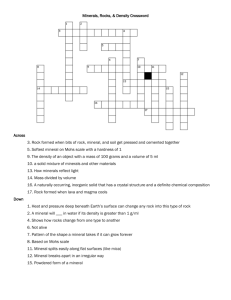Geology & Mineral Resources: Chapter Summary
advertisement

Chapter 14 Geology and Nonrenewable Mineral Resources Summary 1. Tectonic plates have rearranged the earth’s continents and ocean basins over millions of years like pieces of a gigantic jigsaw puzzle. The plates have three types of boundaries. Natural hazards such as earthquakes and volcanoes are likely to be found at plate boundaries. 2. Rocks are large, natural, continuous parts of the earth’s crust. There are three major types of rocks: igneous, sedimentary, and metamorphic. Rocks are affected by changes of physical and chemical conditions that change them over time from one type to another through the rock cycle. 3. Mineral resources include all naturally occurring materials that are used for human purposes. These resources include metals and fossil fuels, and the distribution of these materials across the earth’s surface is highly variable leading to concentrated deposits in certain areas (e.g., diamonds in Angola or oil in Saudi Arabia). This unequal distribution can lead to conflicts and has implications for national security and international relations. 4. Mineral resource extraction methods include surface and subsurface mining. Surface mining types are open-pit, strip, contour strip mining, and mountain removal. Resource extraction technologies are constantly changing but always create some environmental disturbance. In some cases, the environmental impacts of mineral extraction can be severe. 5. All mineral resources are finite but the lifetime of materials varies with the rate of use and the size of the resource. Recycling of mineral resources leads to a longer depletion time compared to those that cannot be reused or recycled. 6. Scientists are developing new types of materials as substitutes for many metals. Mineral conservation and more sustainable manufacturing processes are helping to decrease our use and waste of such resources. Recent, dramatic increases in the cost of minerals are driving aggressive recycling of many resources and particularly metals (e.g., copper). Key Questions and Concepts 14-1 What are the earth’s major geological processes and hazards? CORE CASE STUDY: Gold extraction produces a tremendous amount of mining waste and can pollute the air and water. Cyanide is commonly used to extract gold and it is extremely toxic. In 2000 a cyanide leach pond was washed out in Romania, leading to environmental catastrophe downstream on the Tisza and Danube Rivers. A. The earth is made up of a core, mantle, and crust and is constantly changing as a result of processes taking place on and below its surface. Geology is the study of dynamic processes occurring on the earth’s surface and in its interior. B. Huge volumes of heated and molten rock moving around the earth’s interior form massive solid tectonic plates that move extremely slowly across the earth’s surface. About 12 or so rigid tectonic plates move across the surface of the mantle very slowly. These thick plates compose the lithosphere. C. The movement of these plates produces mountains on land and trenches on the ocean floor. The movement of plates also produces earthquakes and volcanic action. D. Some processes wear down the earth’s surface by moving topsoil and pieces of rock from one place to another, while other processes build up soil on the earth’s surface. Weathering is the physical, chemical, and biological processes that break down rocks and minerals into smaller pieces. E. Volcanoes often form along the boundaries of tectonic plates. Eruptions can be very destructive. F. Earthquakes are the release of energy accumulated over time along a fault. 1. Tsunamis can result from underwater earthquakes. 14-2 How are the earth’s rocks recycled? A. The earth’s crust consists of minerals and rocks. A rock is a combination of one or more minerals. 1. Sedimentary rock is made of sediment. 2. Igneous rock forms below the earth’s surface. 3. Metamorphic rock forms when preexisting rocks are subjected to high temperatures or pressure. 4. The rock cycle is the interaction of physical and chemical. 14-3 What are mineral resources and what are the environmental effects of using them? A. Mineral resources are concentrations of naturally occurring materials that can be extracted and processed. 1. Ore is a rock with a high concentration of a particular mineral. Can be high-grade, or low-grade. 2. Reserves of minerals are identified resources from which the mineral can be extracted profitably. B. The life cycle of a metal is very energy intensive. C. There are many ways to extract minerals 1. Surface mining 2. Open pit mining 3. Strip mining 4. Contour strip mining 5. Mountaintop removal 6. Subsurface mining a. Identified resources have a known location, quantity, and quality. b. Reserves are identified resources that can be extracted profitably at current prices. c. Undiscovered reserves are potential supplies of a mineral resource assumed to exist. d. Other resources are undiscovered resources and identified resources not classified as reserves. D. Mining scars the land and produces large amounts of solid waste and air and water pollution. The impacts include high costs (into the billions of dollars), subsidence, toxin and acid drainage, toxics emission to the atmosphere. E. After waste material is removed from metal ores they are smelted or treated with chemicals to extract the desired metal. There can be enormous amounts of air and water pollution from these processes. 14-4 How long will supplies of nonrenewable mineral resources last? A. The future supply of a resource depends on its affordable supply and how rapidly that supply is used. A nonrenewable resource generally becomes economically depleted rather than totally depleted. There are five choices at that point: recycle or reuse existing supplies, waste less, use less, find a substitute, or do without. B. A rising price for a scarce mineral resource can increase supplies and encourage more efficient use. Economics determines what part of a known mineral supply is extracted and used. Higher prices often mean more resources can be used (at a higher extraction cost), but this can be affected by national policies that subsidize exploration or restrict exports/imports. CASE STUDY: The US General Mining Law of 1872 was designed to encourage hard rock mining on public lands. Many people have become wealthy by exploiting this law for mining and to other ends. Cleaning up degraded land and streams has cost taxpayers large sums of money. Critics call for tighter environmental controls and higher royalties to be paid by the mining companies. C. New technologies can increase the mining of low-grade ores at affordable prices, but harmful environmental effects can limit this approach. In 1900, the average copper ore mined in the U.S. was about 5% copper by weight; today that ratio is 0.5%. D. Most minerals in seawater and on the deep ocean floor cost too much to extract, and there are squabbles over who owns them. Rich hydrothermal deposits of gold, silver, zinc, and copper are found as sulfide deposits in the deep-ocean floor and around hydrothermal vents. Another potential source from the ocean floor is potato-sized manganese nodules that cover large areas of ocean floor. 14-5 How can we use mineral resources more sustainably? A. Scientists and engineers are developing new types of materials that can serve as substitutes for many metals. This is known as the materials revolution. For example, development of silicon and ceramics may replace the need for as much metal. B. Recycling valuable and scarce metals saves money and has a lower environmental impact than mining and extracting them from their ores. In many cases, metals are actively recycled. C. We can use mineral resources more sustainably by reducing their use and waste and by finding substitutes with fewer harmful environmental effects. SCIENCE FOCUS: Nanotechnology involves the manipulation of atoms and molecules to create materials. The technology is very promising, but there are drawbacks. It is suggested that we carefully investigate risks and develop guidelines and regulations until more is known about potentially harmful effects. CASE STUDY: 3M is a company that has used waste prevention as means of attaining cleaner production. .




